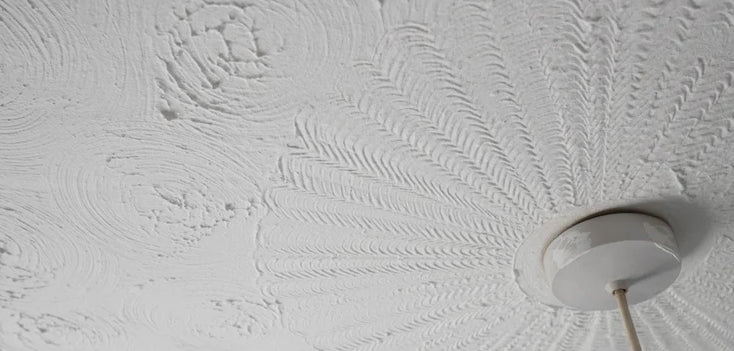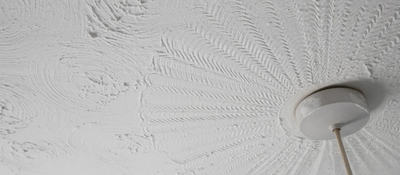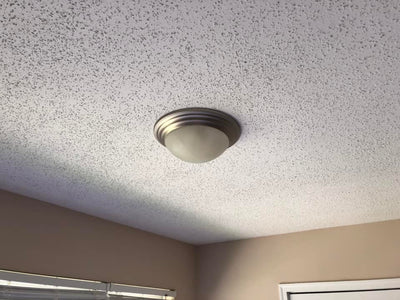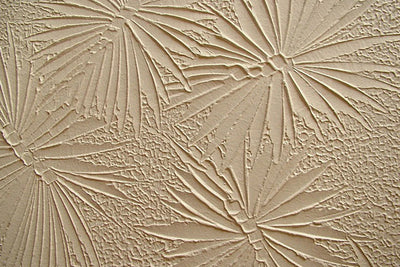Asbestos Artex



Written by Tom Yates . Edited 8th December 2023
Fact Checked by William Wright, NEBOSH
Overview
Artex is a common surface coating frequently seen on domestic ceilings across the UK. Today Artex is used as a general term to describe a particular design of ceiling coating. However, the name comes from the company Artex Limited, who popularised the style throughout the latter half of the 20th century.
When people refer to Artex, they usually mean the ceiling style/design rather than the company themselves. Artex ceilings are also historically associated with asbestos, which still exists within many properties today.
In the below guide, I explain everything there is to know about asbestos Artex so you are armed with knowledge and can act if needed.
What does asbestos artex look like?
Like most asbestos-containing materials, asbestos artex is indistinguishable from textured coatings which do not contain asbestos.
Artex (with or without asbestos) is often white in a bumpy swirling pattern / texture . It can be found on ceilings & walls all over the UK in homes and offices. It’s also used in a range of different rooms such as bathrooms, bedrooms and kitchens.
Most of us will be familiar with the style of Artex when we see it. It’s similar to many other ceiling designs too, but ceilings that are unmistakably Artex should be tested for asbestos before any renovation work begins.
There's only one way of knowing for sure if the artex you're looking at contain asbestos, and that is to have the textured coating tested in a laboratory. If the building was built before 1999 and you spot a swirly or bobbly paint, it is recommended that you assume that it may contain asbestos.




Fact Sheet
Identifying asbestos artex
Here are some frequently asked questions regarding identifying asbestos artex, if you have any questions which we've missed in this article please contact us and one of our asbestos specialists will respond to your question.
What are the most common artex patterns / designs
+
-
Unfortunately there is no common theme to look for with artex, most designs are unique as they where created by the painter / decorator applying the textured coating. Any raised paint should be considered.
Does all Artex contain asbestos?
+
-
No not all Artex contains asbestos, however it did commonly contain asbestos pre 1990. It's always worth testing artex which was applied before the year 2000 to ensure it doesn't contain asbestos.
How do you take a sample of artex?
+
-
Taking an accurate representative sample of an artex ceiling is achieved by taking deep scrapings from multiple locations of the same surface (this is because its application was sporadic and so could be positive in some areas and negative in others) We have developed an more in-depth guide which you can read here
Where is it commonly found?
Artex is most commonly found on the ceilings and walls of properties built pre-2000. It was used more heavily in residential properties however it was still used in commercial buildings.
How dangerous is asbestos Artex?
Asbestos artex coatings are considered a lower-risk asbestos-containing product. This is due to the material makeup. With the material being heavily bonded and non-friable (Friability is the tendency to break down, chip or crumble under pressure or as a result of abrasion) this means when the product is disturbed or broken there is a minimal release of asbestos fibres.
Whilst artex is considered lower-risk by the HSE (Health & Safety Executive)[1]this doesn't mean that the product isn't harmful and certainly doesn't mean it is safe to remove without protection. If you intend to work on asbestos artex then ensure you wear appropriate RPE & PPE.
We would always recommend getting an asbestos removal company in to do any removal/maintenance on your Artex.
The facts about asbestos exposure
Asbestos exposure can lead to diseases such as asbestosis, lung cancer, and mesothelioma. These diseases often have a long latency period, meaning symptoms may not manifest until many years after exposure.

Tom Yates
03/01/2023

Is a license required for removal?
According to the HSE an asbestos license is not required to remove Artex. However in certain circumstances a notification (NNLW) will still be required.
Asbestos artex statistics in the UK
We carry out thousands of tests per year, and as such we have accumulated an extensive data set that we can call upon. According to our data around 60% of the samples we test are artex / textured coating samples which includes. This makes artex the most tested material. Of those tested, 17% of the samples came back with a positive result (containing asbestos).
If we are to generalise this data we could assume that if you find a textured paint in your house there is a 17% chance that it contains asbestos. Regardless of the stats you can never assume the material is non-asbestos contain and so you should always exercise caution.
Of those tested, 17% of textured coatings came back with a positive result.
(Results from samples sent to Asbestos Sampling in 2023)
Frequently Asked Questions
Can you plaster over Artex?
+
-
Plastering over asbestos artex is an option. However it should be done with caution and if any tradesmen are being appointed to do the works they should be made aware of the asbestos identification so they can risk assess accordingly. The problem with plastering over asbestos containing artex is it is simply hiding the risk. For example if you where to move out of the property and the new homeowner was unaware they may drill into the newly plastered ceiling to attach a light fitting and expose themselves to asbestos fibres released when they hit the old artex. This is why we would always recommend having it removed.
Can I Remove It Myself?
+
-
If you are the owner of the property and it is classed as a domestic dwelling then there are no laws preventing you from removing the artex yourself, however, we would always recommend instructing professionals to carry out any removal works for you to protect your health.
If you are an employee or the property is classed as non-domestic or commercial then you are bound by the laws of the HSE. You may be able to remove them yourself providing you have relevant training and experience in doing so. It's worth checking the HSE guidance on this to ensure you're not contravening any health & safety laws.
Can you board over asbestos Artex?
+
-
Potentially. Whilst we would always recommend having them removed by professionals, some property owners would prefer to save the expense and simply cover the Artex up such as over boarding. However, if you need to screw or nail into the old asbestos ceiling to affix the new plasterboard then this would disturb the artex and cause a release of asbestos fibres. So we advise against this option.
Can I keep my artex / leave it in situ
+
-
If your artex is in good condition and not deteriorating then you are fine to keep it in situ. It won't be causing any harm as the material is heavily bonded and sealed by the paint.
As a precaution you may want to apply new coatings of paint every few years to maintain its condition and keep it all sealed.
However, if you need to disturb the artex then encapsulation isn't going to help.
How to dispose of artex?
+
-
To dispose of asbestos in line with legislation the boarding should be bagged up using UN-certified asbestos waste bags. The material should be first put into the red bag which is then sealed using heavy-duty tape to create an air-tight seal. The clear bag should then be placed inside the red bag and again sealed with tape. This technique is called double-bagging. These bags can then be taken to the hazardous waste skip at a local waste recycling facility.
References / Citations
- 1. "A28 - Asbestos Essentials", Health & Safety Executive [view source] . Retrived 6th August 2023
Quick Links
Full PPE Included
Full Asbestos Testing Kit
Test for asbestos yourself using one of our kits
- Results within 24hrs
- Tested at UKAS Accredited Lab
- Instructions & PPE Included
Want to learn more?
He's some other interesting articles we've written:
What is AIB / Asbestos Insulation Board
Get an Asbestos Removal Quote
How Much Does Asbestos Cost To Remove?


